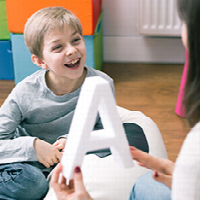What are Reading Disorders?
Reading disorders occur when a person has trouble with any part of the reading process. Reading and language-based learning disabilities are commonly called dyslexia. These disorders are present from a young age and usually result from specific differences in the way the brain processes language.
There are many different symptoms and types of reading disorders, and not everyone with a reading disorder has every symptom. People with reading disorders may have problems recognizing words that they already know and may also be poor spellers. Other symptoms may include the following:
- Trouble with handwriting
- Difficulty reading quickly
- Problems reading with correct expression
- Problems understanding the written word
Reading disorders are not a type of intellectual and development disorder, and they are not a sign of lower intelligence or unwillingness to learn.
People with reading disorders may have other learning disabilities, too, including problems with writing or numbers. Visit learning disabilities for more information about these problems.
Types of Reading Disorders
Dyslexia is a brain-based type of learning disability that specifically impairs a person's ability to read. Individuals with dyslexia typically read at levels significantly lower than expected despite having normal intelligence. Although the disorder varies from person to person, common characteristics among people with dyslexia are difficulty with phonological processing (the manipulation of sounds), spelling, and/or rapid visual-verbal responding. Dyslexia can be inherited in some families, and recent studies have identified a number of genes that may predispose an individual to developing dyslexia. Examples of specific types of reading disorders include:
- Word decoding. People who have difficulty sounding out written words; matching the letters to sounds to be able to read a word.
- Lack of fluency. People who lack fluency have difficulty reading quickly, accurately, and with proper expression (if reading aloud).
- Poor reading comprehension. People with poor reading comprehension have trouble understanding what they read.
A related problem is alexia (pronounced uh-LEK-see-uh), or an acquired inability to read. Unlike most reading disabilities, which are present from when a child starts to learn to read, people with alexia were once able to read but lost the ability after a stroke or an injury to the area of the brain involved with reading.
How are reading disorders diagnosed?
Diagnosing reading disorders usually involves a series of tests of a person’s memory, spelling abilities, visual perception, and reading skills. Family history, a child’s history of response to instruction, IQ tests, and other assessments might also be involved.
The International Dyslexia Association has two fact sheets about evaluation and diagnosis for a reading disorder:
. Evaluating a child for a reading disorder
. Evaluating an adult for a reading disorder (PDF - 149 KB).
The U.S. Department of Education offers services and assistance to support people with dyslexia and specific learning disabilities through its Office of Special Education Programs (OSEP). Visit http://www2.ed.gov/parents/needs/speced/resources.html for more information.
The OSEP also supports the Parents Technical Assistance Center Network, which can help parents learn about their children’s reading or other disabilities, assist them with connecting with and talking to professionals about their children’s disabilities, and help them understand the laws and policies related to education for a child with a disability such as dyslexia. Visit http://www.parentcenterhub.org/find-your-center/ for more information.
What are common treatments for reading disorders?
Early, intensive instruction in language and different aspects of reading by specialized teachers is the best way to improve reading skills. The most appropriate treatment strategy depends on the needs of the individual.
Reading disorders cannot be cured, but people with these disorders can overcome specific problems, learn to read, and improve fluency and comprehension with proper instruction, especially if they receive help and instruction early.
Because there is no single treatment for reading disorders, there is also no single resource that provides comprehensive information about treatment for reading disorders. However, a few good places to start are:
. U.S. Department of Education (ED), Institute of Education Sciences: What Works Clearinghouse
. ED, Office of Special Education and Rehabilitative Services
. International Dyslexia Association: Information on Interventions and Instructions
Read more about educational treatments for children with different types of specific learning disabilities, including reading disabilities, at the NICHD’s Learniupdateties A to Z webpage.
Courtesy: Eunice Kennedy Shriver National Institute of Child Health and Human Development
References:
https://www.nichd.nih.gov/health/topics/Pages/index.aspx












